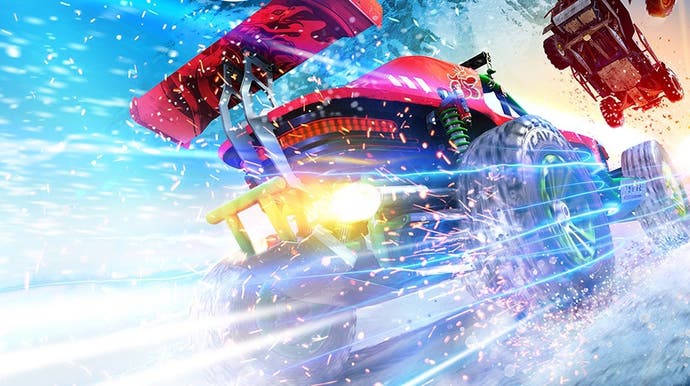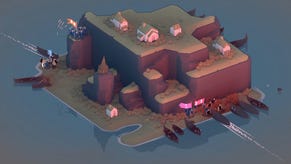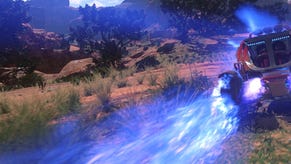Evolution Studios reborn: the cutting-edge tech of Onrush
How a former first-party studio built its first multi-platform game.
World Rally Championship, MotorStorm, DriveClub - Sony may have jettisoned developer Evolution Studios from its first-party line-up, but the studio lives on in the form of Codemasters Evo, and after two years of work, it's on the cusp of releasing its new game: Onrush. What we're looking at here is effectively the same team with the same focus on technologically advanced racing games, still operating from the same studio space in Runcorn, Cheshire. The key difference is that the studio has moved onto multi-platform development, a fundamental shift after years of supporting PlayStation systems only.
The end result is a new arcade racing title built on a brand new engine, releasing next week on PlayStation 4 and Xbox One, with a PC version to follow. At first glance, Onrush is reminiscent of Evo's iconic work on MotorStorm, but look further and you'll see definite influences from Burnout and SSX - not least in its pursuit of intense action rendered at a slick 60 frames per second. With 24 cars on-screen in the 'stampede' and an array of physics and destruction in play, Onrush at its most insane looks quite unlike any other current-gen racer - and it's a technological achievement made possible by ditching legacy code, rebuilding the studio's engine from the ground up.
Beginning by taking a look at Codemasters' established multi-platform Ego engine, the team added in support for technologies it had used previously, like Havok physics, before crafting its own bespoke rendering solution based on DX12 and the low-level graphics API used by PlayStation 4. This involved going 'bindless' - instead of binding resources to the API for every draw call, Evo groups elements together, putting them into a group that is binded just once before rendering. This greatly reduces CPU utilisation, which is a big deal in a world where current-gen console designs make CPU time such a precious resource.
According to Evo, 30fps was the target for 18 months of the two-year development cycle, with all art created with that frame-rate in mind. However, moving to the lower-level APIs opened up the headroom to target 60fps instead. Initially, this would be the preserve of the enhanced consoles only, but as the team focused more intensely on high frame-rate support towards the tail-end of development, the standard PS4 became a viable target too. Only the regular Xbox One doesn't feature it as standard at launch - though the team continues to work on it. Those who prefer high pixel-counts can go for a resolution-focused mode though, available on base PS4, Pro and Xbox One X. As it happens, the performance mode still holds up visually - Evo uses a temporal reprojection anti-aliasing solution that does a tremendous job of smoothing off the jaggies and resolving in-surface aliasing.
The initial focus on 30fps action is reflected in the quality of the assets. Take the cars, for example. The full LOD models average out at around 180,000 polygons per vehicle. That is a reduction from the straight quarter-million of DriveClub, but that's not a bad trade considering that Evo doubles frame-rate in the final release and renders up to 24 cars on-screen simultaneously. Wheels and tyres alone use 20,000 polygons, enhanced with parallax occlusion mapping, with detail to the point where tread accumulates dirt or snow. These vehicles feature procedural damage too - bending and warping according to collision points and velocity of impact. There's a great deal of simulation on the vehicles from the suspension to the gearbox to the tyres, but that's just the beginning - the models are tweaked for 'fun', most notably with what the developer calls 'cat physics', where the maths are massaged to ensure the player vehicle is more likely to land on its wheels after huge jumps or barrel rolls.
Also surprising is the emphasis on dynamic lighting and weather conditions in the circuits. Like DriveClub before it, there's a wide selection of large scale, lush environments, with a new focus on using photogrammetry. The basic idea involves capturing footage of actual landscapes and rock formations using a high-end drone, with photo-scanning software used to convert the video into texture that can be manipulated by Evo's artists, where they can then be tweaked using tools like Maya and ZBrush. The process cuts development time by half and produces higher quality assets. All of this is enhanced with a reliance on physically accurate materials, first deployed by the team in MotorStorm Apocalypse and refined and perfected in DriveClub.
Very little in terms of lighting is 'baked' or pre-calculated and this is key to the concept of Onrush's single-player progression system. Races can occur at any time of the day, with lighting conditions continuing to shift during the action as time passes. On a more global level, all four seasons are simulated, meaning radically different weather and even an accurate modelling of sun position. In addition, each season features its own attributes: flowers and trees bloom during spring and summer, changing colour when Autumn hits and withering as winter kicks in. And on top of these systems is dynamic weather too: rain and thunderstorms occur throughout the year, while heavy snow is a possibility during winter. Here, an approximation of snow accumulation is implemented, to the point where the weight of the snow causes tree branches to sag.
With that attention to detail in place, you can also expect puddles to form after heavy rain, and even individual rain drops can be lit by dynamic lighting - like lightning, for example. It's the logical evolution of technology from the same developer that brought us DriveClub's superb weather system. Evo has also implemented geometric tyre tracks and water trails, to show the vehicles interacting more fully with the environments. There's also a full real-time cloud simulation in place.
Also key to the look of the game is Evo's implementation of volumetric lighting and height-based fog, which works in tandem with the weather system. Dynamic lights - most notably the sun - interact with the atmosphere to produce rich crepuscular rays. This effect uses a screen-space grid divided into many depth slices, where every dynamic light source can produce an associated effect. The sun, headlamps and street lights all take advantage of this system and as the engine is built on a deferred renderer, the cost of individual lights is extremely low, meaning an abundance of them through the game.
Put simply, for all of this to be achieved at 60fps, in addition to processing physics for up to 24 vehicles (with the additional netcode overhead of 12 human players) is quite an achievement. But if there is one issue with Evo's fully dynamic approach, it's that the combination of lighting, weather and time of day can be somewhat uneven. The beach track on a sunny afternoon - a combination seen frequently in the recent beta - doesn't look as striking as the exact same circuit rendered at sundown during a storm. However, it's key to achieving a sense of variety in single-player progression - something users haven't been able to sample just yet: switching up all elements of the environment helps to keep things fresh.
We like what we've seen so far with Onrush, and having spent some time with gold master code, it's fair to say that the recent beta version of the game only offers a small glimpse of the whole game. What we can say for sure is that performance and stability has certainly improved - indeed, when the beta code hit early last month, that version of the game was already five weeks old and optimisation in the run up to launch has been a key focus for the team.
Onrush took 24 months to develop, with the Codemasters Evo team averaging just 60 people across the duration, making it a small-scale project by today's megalithic triple-A standards. But it is a team that has stuck together through thick and thin - and experience counts. The merging of arcade fun and simulation that defined MotorStorm is present and correct here, ramped up via inspiration from Burnout and SSX. But in addition to that, there's also the same focus on technological innovation that you'd expect from the developer behind DriveClub. But with all of that said, the commercial realities surrounding arcade racers means that it's been something of a dark time in recent years, and Onrush's unique stampede gameplay is quite the gamble. We'll find out to what extent it pays off when Onrush debuts on June 5th.









